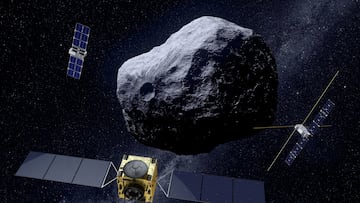Hera Mission: What is it? When is the SpaceX launch? How to watch
Following in the footsteps of DART, the European Space Agency’s Hera Mission will soon launch from Cape Canaveral aboard a SpaceX Falcon 9.

The European Space Agency (ESA) is sending a space probe to investigate the asteroid Dimorphos which was part of a international planetary defense experiment in 2022. In order to exam the possibility of changing the course of some future potentially earth-bound asteroid, NASA’s DART (Double Asteroid Redirection Test) spacecraft crashed into the moonlet of Didymos, its larger partner near-Earth asteroid.
The DART Mission was a success, and now the ESA is set to send its contribution, the Hera Mission, as part of the international double-spacecraft collaboration. Hera will rendezvous with the binary asteroid system to perform a post-impact survey and analyze the outcome of NASA’s planetary defense experiment.
📽️Call it the 3 body problem: Once #HeraMission reaches its target binary, @ESA's planetary defence spacecraft must navigate around 2 asteroids rather than just 1. Here's how it's going to do it https://t.co/ljZO20mhom pic.twitter.com/c1IwHFsOZp
— ESA's Hera mission (@ESA_Hera) October 5, 2024
Hera Mission: When is the SpaceX launch? How to watch
The launch window for Hera, named after the Greek goddess of marriage, will open on Monday, October 7, 2024 at 10:52 am EDT. It will be launched into interplanetary transfer orbit atop a SpaceX Falcon 9 rocket leaving from Space Launch Complex 40 (SLC-40) at Cape Canaveral Space Force Station in Florida.
ESA will livestream the launch on various platforms including ESA WebTV, ESA YouTube and on ESA’s X, and LinkedIn accounts. The launch can also be viewed live on X @SpaceX, the broadcast will begin 15 minutes before launch.
Should conditions not permit liftoff on Monday, “a backup launch opportunity is available on Tuesday, October 8 at 10:46 am EDT,” states SpaceX.
Hera Mission: What is it?
The Hera Mission will reach the binary asteroid system in 2026. These systems make up around 15% of all known asteroids and are a little understood class of asteroids. Once there it will focus on the smaller of the two bodies, which is roughly circular measuring 160m, about the same size as the Great Pyramid of Giza.
However, it will have its own “3 Body Problem” having to navigate its orbit around not just Dimorphos, but also Didymos, which is the 780 meter-diameter mountain-sized main body.
Related stories
The spacecraft will “perform high-resolution visual, laser and radio science mapping of the moon, which will be the smallest asteroid visited so far, to build detailed maps of its surface and interior structure,” the ESA informs.
Two cubesats, Milani and Juventas, will also be deployed to help with the analysis, studying the asteroids internal structure, surface minerals and gravity. The mission “will also demonstrate multiple novel technologies, such as autonomous navigation around the asteroid – like modern driverless cars on Earth,” says ESA. The data collected “will help scientists and future mission planners better understand asteroid compositions and structures.”



Complete your personal details to comment